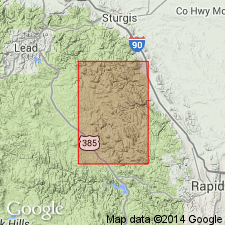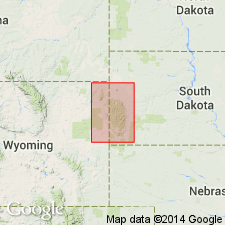
- Usage in publication:
-
- Nemo Group*
- Modifications:
-
- Revised
- AAPG geologic province:
-
- Midcontinent region
Summary:
Type locality stated to be the exposures in vicinity of Nemo, sec 27, T3N, R5E, Meade Co, SD. Use of Nemo "system" or "series" modified to Nemo Group. Nemo divided into two newly named formations of middle Precambrian age--Boxelder Creek Quartzite at the base and Benchmark Iron-formation at the top. The formations of the group, which are separated from each other by an unconformity?, are mapped in Lawrence, Meade, and Pennington Cos, SD in the Midcontinent region. The group unconformably overlies the early Precambrian Little Elk Granite and unconformably underlies the middle Precambrian Estes Conglomerate (revised).
Source: GNU records (USGS DDS-6; Denver GNULEX).

- Usage in publication:
-
- Nemo Iron-formation
- Modifications:
-
- Revised
- Age modified
- AAPG geologic province:
-
- Midcontinent region
Summary:
Follows usage of Reddin (1981)--formation rank rather than Bayley (1972)--group rank. Mapped with Early Proterozoic iron-formations (Xif, Pl. 1). May be Archean? age based on relationship to underlying metasedimentary rocks that were intruded by the Little Elk Granite which has been dated as 2.51 Ga. Geologic map.
Source: GNU records (USGS DDS-6; Denver GNULEX).
For more information, please contact Nancy Stamm, Geologic Names Committee Secretary.
Asterisk (*) indicates published by U.S. Geological Survey authors.
"No current usage" (†) implies that a name has been abandoned or has fallen into disuse. Former usage and, if known, replacement name given in parentheses ( ).
Slash (/) indicates name conflicts with nomenclatural guidelines (CSN, 1933; ACSN, 1961, 1970; NACSN, 1983, 2005, 2021). May be explained within brackets ([ ]).

